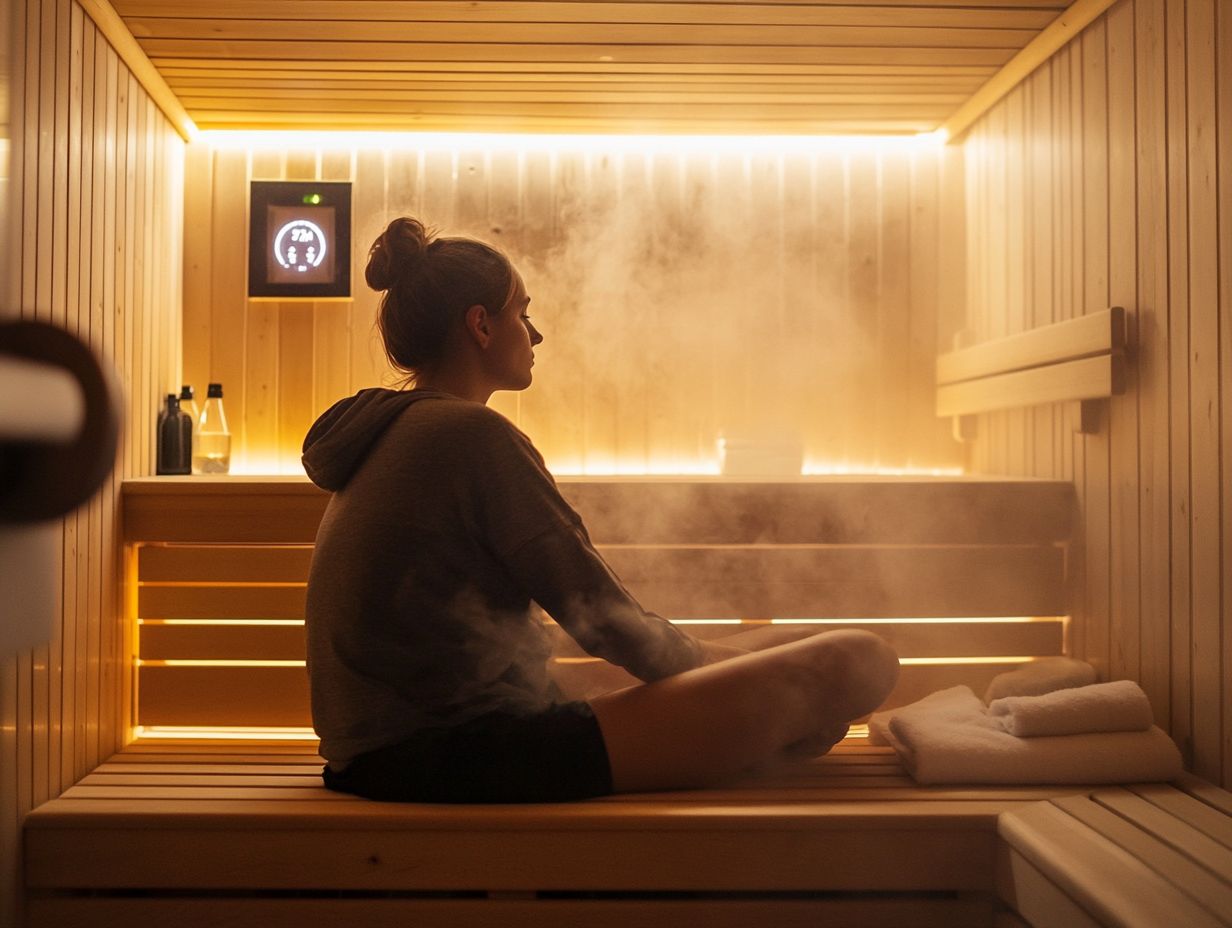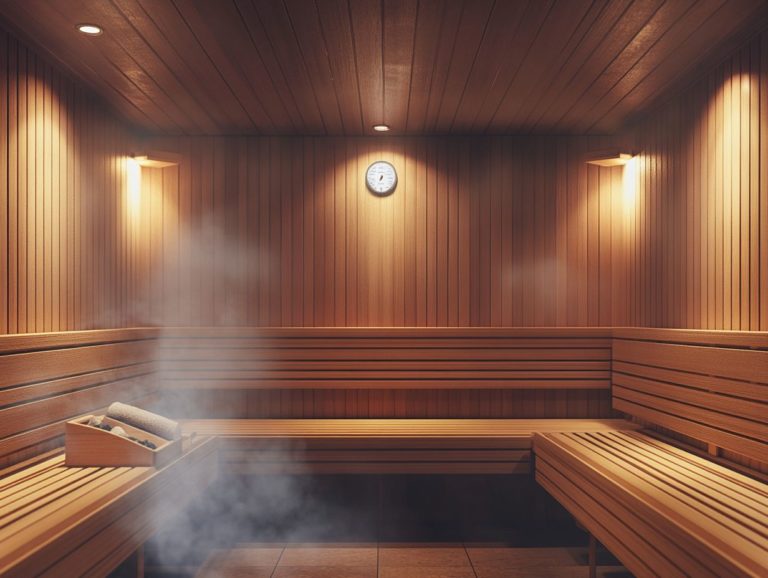Sauna Safety: How to Stay Informed
Saunas provide a remarkable fusion of relaxation and health benefits. Grasping the nuances of safe usage is essential for ensuring a positive experience.
This article delves into the essence of saunas and their operation. It examines potential health risks and outlines crucial safety practices.
Whether you re a seasoned sauna enthusiast or a curious beginner, understanding how to select the right sauna and staying informed about safety features will elevate your enjoyment.
Discover essential tips to enjoy sauna safety and maximize your relaxation now!
Contents
- Key Takeaways:
- Understanding Sauna Safety
- Potential Risks and Dangers
- Safe Usage Practices
- Choosing the Right Sauna
- Staying Informed about Sauna Safety
- Frequently Asked Questions
- What are the main safety concerns when using a sauna?
- Are there any specific health conditions that may make using a sauna unsafe?
- What should I do to prepare for a sauna session, and what are the sauna benefits?
- What is the recommended amount of time to spend in a sauna, and how can I keep sessions safe and comfortable?
- How do I stay informed about sauna safety and the latest research on sauna types?
- What should I do if I start to feel unwell while using a sauna, and how can I monitor feelings during my sessions?
Key Takeaways:

- Always consult a doctor before using a sauna if you have any pre-existing health conditions or concerns.
- Make sure to properly hydrate before and after using a sauna, and listen to your body for any signs of discomfort or overheating.
- Stay informed about sauna safety by regularly checking reputable resources and organizations for up-to-date information and guidelines.
Understanding Sauna Safety
Understanding sauna safety is crucial for you to fully enjoy the myriad benefits that saunas offer while minimizing any potential health risks. With roots in traditions such as those from Finland, saunas provide a tranquil setting that promotes relaxation, supports cardiovascular health, and alleviates muscle soreness, among many other wellness perks.
Using a sauna incorrectly can cause health issues. To ensure a safe and enjoyable experience, it’s important to follow sauna safety guidelines about hydration and session lengths.
What is a Sauna and How Does it Work?
A sauna is a cozy retreat designed to heat you up, with options like wood-burning, electrically heated, infrared, and steam rooms each offering a distinctly different experience. These environments promote sweating, helping to eliminate toxins and enhance your overall health.
When you step inside a sauna, the air typically dances between 150 and 195 degrees Fahrenheit, depending on the type you choose. Traditional saunas harness dry heat, encouraging perspiration and boosting circulation.
Infrared saunas use infrared light, which heats your body directly, providing therapeutic benefits without excessively elevating the ambient temperature.
Steam rooms envelop you in a humid embrace, promoting sweat and deep relaxation. Each variation not only aids in muscle relaxation but also supports skin rejuvenation, bolsters cardiovascular health, and enhances mental clarity through an overall sense of well-being. Understanding the importance of encouragement in sauna safety can further enhance your experience.
Potential Risks and Dangers
While saunas are celebrated for their numerous health benefits, it’s equally important for you to recognize the potential risks and dangers that can accompany their use. If you have medical conditions like high blood pressure, diabetes, heart disease, or arthritis, be careful.
Talk to a doctor before using a sauna, especially if you have health concerns. Your well-being should always come first.
Health Concerns and Precautions

Health concerns related to sauna use can emerge, especially if you don t keep an eye on how you re feeling or if you choose to linger in the heat for too long. Keep your sessions short and always listen to your body s signals; recognizing signs of discomfort is crucial for maintaining your sauna safety.
If you have pre-existing conditions, such as cardiovascular issues or respiratory problems, it’s essential to consult a healthcare professional before diving into sauna sessions. Additionally, understanding sauna safety and the role of positivity can enhance your experience.
To mitigate risks, establish a routine that emphasizes hydration both before and after your sauna experience. Taking breaks to cool down is also a smart practice. Monitoring your heart rate while in the sauna can serve as a practical safeguard. For more detailed information, check out the guidelines on sauna use for the elderly. Ideally, aim for sessions lasting no longer than 15 to 20 minutes, striking a harmonious balance between enjoyment and safety.
By prioritizing your personal safety and being attentive to your body’s signals, you can fully embrace the therapeutic benefits of the sauna while minimizing any potential health concerns.
Safe Usage Practices
Practicing safe usage habits is crucial for fully enjoying the benefits of your sauna sessions while minimizing potential risks.
To ensure a safe experience, consider implementing the following:
- Buddy system
- Dressing appropriately
- Staying well-hydrated
- Steering clear of alcohol, which can worsen dehydration and amplify other hazards.
Tips for Sauna Safety
When you step into a sauna, there are several tips that can truly elevate your experience while prioritizing safety. Keep an ear out for your body s signals throughout the session and remember to keep your time short to avoid overheating. Protecting your hair and following proper sauna hygiene can significantly enhance the overall environment.
Staying hydrated before and after your sauna visit is crucial, as the heat can lead to increased fluid loss. Wearing loose-fitting and appropriate clothing will also boost your comfort and help regulate your body temperature during your time inside. To ensure a safe and enjoyable experience, familiarize yourself with sauna safety for athletes. Consider indulging in a pre-sauna shower; it not only promotes hygiene but also helps your body adjust to the heat.
Pay close attention to how long you spend inside, especially if you have existing health conditions or are new to the experience. Regularly maintaining the sauna, ensuring it remains clean and at proper temperature settings, will not only heighten your satisfaction but also foster a safe and enjoyable environment.
Choosing the Right Sauna
Choosing the right sauna requires a thoughtful exploration of the various types available, alongside careful consideration of factors like placement whether you prefer it indoors or outdoors and the equipment you’ll need.
With options such as wood-burning, electrically heated, and infrared saunas, you can cater to your specific preferences, ensuring that your sauna experience is nothing short of exceptional.
Types of Saunas and Safety Features

You ll find there are several types of saunas to explore: wood-burning, electrically heated, infrared, and steam rooms. Each offers unique safety features and benefits designed to cater to your specific needs. Understanding these characteristics, along with the associated safety measures, allows you to make an informed choice.
For instance, wood-burning saunas create a traditional ambiance, complete with safety features like heat-resistant materials and proper ventilation to prevent any carbon monoxide buildup. On the other hand, electrically heated saunas are celebrated for their convenience, coming equipped with temperature controls and timers to enhance your experience while ensuring a safe environment. To maximize safety, it’s important to follow guidelines like those outlined in sauna safety reminders.
If you’re considering infrared saunas, they utilize advanced technology to provide gentle heat, making them ideal for individuals dealing with muscle or joint pain, all while being designed for low energy consumption for added safety. For optimal usage, it’s important to follow guidelines such as those found in sauna safety: creating a personal plan. Steam rooms, with their humid environment, typically feature slip-resistant flooring and effective drainage systems, creating a relaxing atmosphere that prioritizes your safety.
Staying Informed about Sauna Safety
Staying informed about sauna safety is crucial for anyone looking to fully enjoy the benefits while minimizing the potential risks associated with sauna use.
Trustworthy resources and esteemed organizations like Harvard Health Publications and the National Center for Biotechnology Information offer invaluable insights into sauna safety and health considerations. Additionally, understanding sauna safety and community responsibilities can further ensure a safe and rewarding sauna experience.
Resources and Organizations for Sauna Safety Information
Several reputable organizations provide comprehensive information about sauna safety. Harvard Health Publications and the American Journal of Public Health offer research-backed insights into the benefits and risks associated with sauna use.
The Sauna Association and the World Health Organization present guidelines designed to reduce risks and increase benefits of regular sauna sessions. You can delve into these resources to discover optimal temperature settings, duration recommendations, and hydration tips. For further insights on safety, check out sauna safety: addressing concerns. This ensures your sauna experience is both enjoyable and beneficial.
By leveraging the educational materials from these trusted organizations, you can make informed decisions and adopt practices that prioritize your well-being, leading to a safer and more gratifying sauna experience.
Watch this video to learn more about sauna safety:
Frequently Asked Questions
What are the main safety concerns when using a sauna?

The main safety concerns when using a sauna include dehydration, overheating, and potential burns from hot surfaces. It is important to stay hydrated, limit the length of time spent in the sauna, and be cautious when touching any heated surfaces.
Are there any specific health conditions that may make using a sauna unsafe?
Yes, individuals with heart disease, high blood pressure, or pregnant women should consult their doctor before using a sauna. People with certain skin conditions or those taking medications should also consult with their healthcare provider, as these conditions can complicate sauna use.
What should I do to prepare for a sauna session, and what are the sauna benefits?
Ready for an amazing sauna session? Start by hydrating well! Before using a sauna, it is also recommended to take a shower to cleanse your skin and remove any lotions or oils that may interfere with sweating.
What is the recommended amount of time to spend in a sauna, and how can I keep sessions safe and comfortable?
The recommended amount of time to spend in a sauna varies, but generally, it is suggested to start with 10-15 minutes and gradually increase the time as tolerated. It is important to listen to your body and exit the sauna if you feel too hot or unwell.
How do I stay informed about sauna safety and the latest research on sauna types?
To stay informed about sauna safety, read and follow the instructions provided by the sauna manufacturer. Educating yourself on potential risks and how to prevent them is also helpful. Keeping up with current research and consulting with a healthcare provider can provide valuable information.
What should I do if I start to feel unwell while using a sauna, and how can I monitor feelings during my sessions?
If you start to feel unwell while using a sauna, immediately exit and cool down. Drink plenty of water and rest until you feel better. If symptoms persist, seek medical attention. It is always better to err on the side of caution when it comes to your health.
Have you ever wondered how to maximize your sauna benefits? We encourage you to share your experiences or questions about sauna safety!






